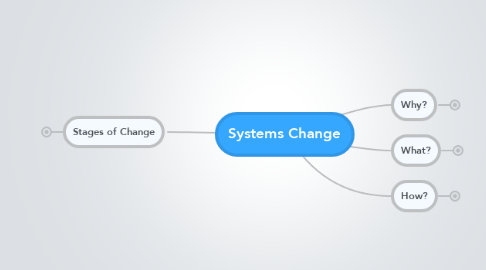
1. Stages of Change
1.1. Consensus
1.2. Infrastructure
1.3. Implementation
1.4. Evaluation of Stages
2. Why?
2.1. Consensus
2.1.1. Shared Vision
2.1.1.1. Involves staff and families
2.1.1.2. Realistic and measurable
2.1.1.3. Understand the need for the idea
2.1.1.4. Perceive to have the skills needed
2.1.1.5. Perceive to have support to develop skills
2.1.2. Shared Mission
2.1.2.1. What is our fundamental purpose?
2.1.2.2. What have we been brought here to do together?
2.1.2.3. What happens when a student experiences difficulty in learning?
2.1.3. Shared Values
2.1.3.1. What are the specific commitments we must honor to achieve our purpose and vision?
2.1.3.2. What are the specific behaviors we can exhibit to make a personal contribution to the success of our school?
2.1.3.3. What commitments are we prepared to make to each other? To each student?
2.1.3.4. What are the "must dos" and the taboos?
2.1.3.5. Shared agreements among all of us?
2.1.4. Climate Change
2.1.4.1. The collective mood or morale of a group (i.e., attitude)
2.1.4.2. National School Climate Standards
2.1.5. Effective Communication
2.1.5.1. Celebration of successes
2.1.5.2. Congruency of words with actions
2.1.5.3. Face-to-face communication
2.1.5.4. Repeating key messages
2.1.5.5. Two-way communication
2.1.5.6. Evaluation of communication
3. How?
3.1. Infrastructure
3.1.1. Policies & Procedures
3.1.1.1. Models
3.1.1.1.1. Problem-Solving Model
3.1.1.1.2. Delivery of Services
3.1.1.2. Decision Rules
3.1.1.2.1. Delivery of support
3.1.1.2.2. Evaluation of support
3.1.2. Professional Learning Communities
3.1.2.1. Purpose
3.1.2.1.1. "We accept learning as the fundamental purpose of our school and therefore are willing to examine all practices in light of their impact on learning."
3.1.2.1.2. "We are committed to working together to achieve our collective purpose. We cultivate a collaborative culture through development of high-performing teams."
3.1.2.1.3. "We assess our effectiveness on the basis of results rather than intentions. Individuals, teams, and schools seek relevant data and information, and use that information to promote continuous improvement."
3.1.2.2. Effective Teaming
3.1.2.2.1. Define roles and responsibilities
3.1.2.2.2. Group norms
3.1.2.2.3. Clear mission of team and meeting
3.1.2.2.4. Using data to guide discussions
3.1.2.2.5. Develop action plans and mechanism for follow-up
3.1.2.3. Levels of Teams
3.1.2.3.1. District-Level Team
3.1.2.3.2. Building Level Team
3.1.2.3.3. Grade/Department Level Teams
3.1.2.3.4. Problem-Solving Teams
3.1.3. Measurable Goals
3.1.4. Resource Mapping
3.1.4.1. Materials
3.1.4.1.1. Assessments
3.1.4.1.2. Interventions
3.1.4.1.3. Curriculum
3.1.4.1.4. Accommodations
3.1.4.1.5. Modifications
3.1.4.2. Staff
3.1.4.2.1. Credentials
3.1.4.2.2. Time
4. What?
4.1. Implementation
4.1.1. Support
4.1.1.1. Coaching
4.1.1.1.1. Internal Supports
4.1.1.1.2. External Supports
4.1.1.2. Professional Development
4.1.1.2.1. Internal Opportunities
4.1.1.2.2. External Opportunities
4.1.1.3. Meeting Availability
4.1.1.4. Communication
4.1.1.4.1. Staff
4.1.1.4.2. Students
4.1.1.4.3. Families
4.1.1.5. Flexibility yet Stability
4.1.1.6. Parent Involvement
4.1.1.6.1. Understanding staff perceptions of parents and their involvement
4.1.1.6.2. Understanding parents' perceptions of their role and the school's
4.1.1.6.3. Collaborating with School
4.1.2. Consistent Delivery of Student, Staff and Family Support
4.1.2.1. Scope & Sequence of Meetings
4.1.2.1.1. Standing agendas items reflecting vision/mission/values
4.1.2.2. Scope & Sequence of Professional Development
4.1.2.2.1. Skills needed
4.1.2.2.2. Support needed
4.1.2.3. Routine Meeting Times
4.1.2.3.1. Built into calendar
4.1.2.3.2. Consistent frequency and duration
4.1.3. Innovation/Idea
4.2. Evaluation
4.2.1. Assess Effectiveness
4.2.2. Make Adjustments
4.2.3. Review Plan
4.2.3.1. Involves agents of the innovation/idea
4.2.3.2. Routine reviews

